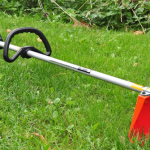Weed trimmers are useful and easy to handle. The modern designing technology has made even the gas operated weed eaters compact and lighter than the old models. There are handy gas trimmers that are super lightweight yet powerful enough to instantly cut-off thicker and bushy areas of your lawn or garden. It is because their engines are already in two-stroke or even four-strokes. A significant improvement has also been developed to reduce their operating noise, though they will never the same level as that of quiet weed eaters that are electrically-powered. Safety features are also being improved. Even then, thousands of people end up in emergency rooms with injuries from weed cutters and trimmers. While some injuries like lacerations of feet, fingers, sprains, and strains are easy to treat, other injuries like wounds to the eyes and lodging of foreign particles in hands and legs are more severe.
Many injuries can occur from any handy weed trimmer tool if the user does not go through the operating precautions in the owner’s manual. The first duty of an owner is to go through the manual thoroughly and understand the safety advice. Then the owner needs to inspect the tool for existing damage and check the cords for fraying. In case of a gas trimmer, the owner needs to store it in a place with enough ventilation; the adjacent garage without any windows might not be the best place to store a gas operated string trimmer.
The ubiquitous safety measures before weeding
Safety goggles, masks, gloves, long thick pants and long-sleeved jacket or shirt is necessary while operating any weed eater. If you have to start the gas operated tool, take it outside first. Next, check the ground for potential projectiles. Small glass particles, pebbles, and metal pieces are perfect candidates for becoming projectiles.
It is not uncommon for a fuel powered trimmer to run out in the middle of cleaning. You must remember not to refuel when the engine is hot. Always wipe the weed hacker down with a clean cloth and wait for it to cool a bit. Make sure you have removed old oil spots, bits of grass and debris before starting to refuel.
How to mix fuel for a weed trimmer?
The mix of fuel to oil ratio depends on the model of your weed eater. Each manual comes with specifications that state the amount of fuel that goes with oil. Some run on a 32:1 ratio, while others can operate on a 40:1 and 50:1 ratios as well. Any two-cycle weed eater will require the proper ratio of fuel and oil to function. Putting too much oil makes the engine smoke. It can ruin your machine. Always remember to mix the amount of oil you can use up within the next 30 days.
Which fuel is right for your trimmer?
The type of fuel also depends upon the make and model of your weed trimmer. Most common trimmers can run on regular gasoline. Marine oil for liquid cooled two-cycle motors is not ideal for any string trimmers. Do not try diesel fuel as it can make the engine smoke as well. You can try alternative fuels like methanol and ethanol if the manual mentions their use. You can use either one of these if you can make up a 10:2 ratio. Do not use any fuel that has more than 10% alcohol, unless the manual specifically mentions special allowance.
The proper weed eater needs proper service and care. Once you start taking care of the tool correctly, the chances of your injuries become significantly lesser as well.







